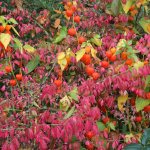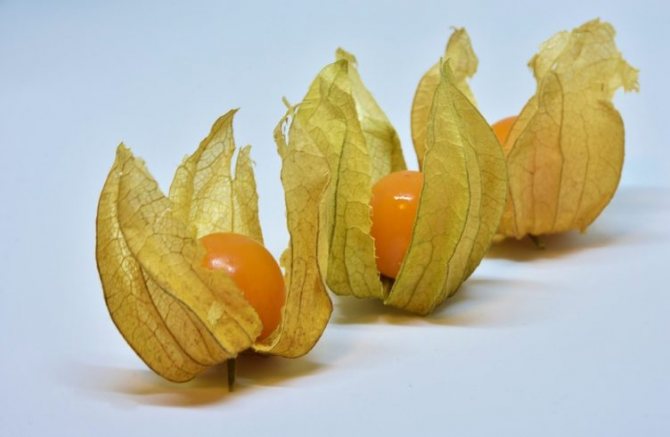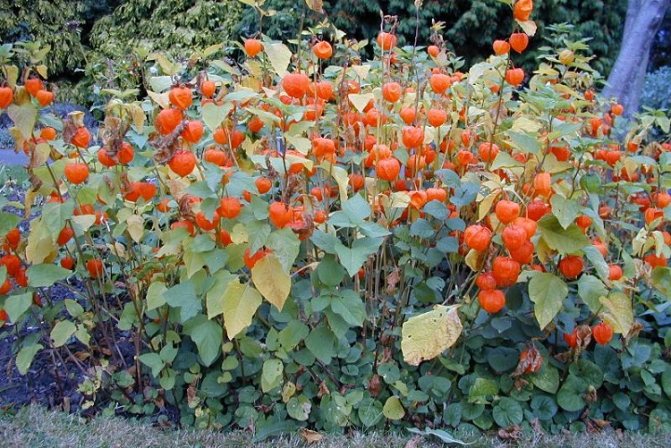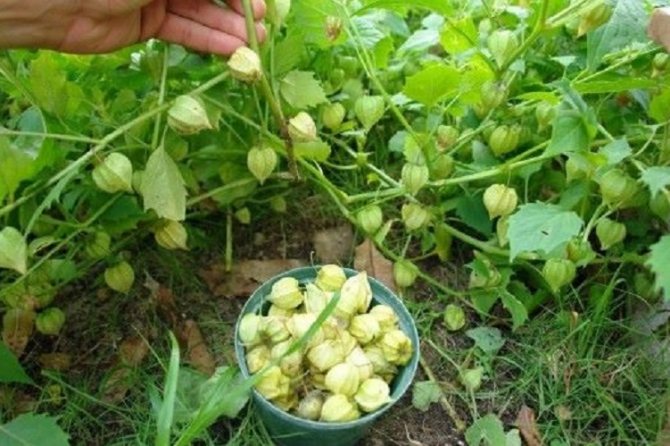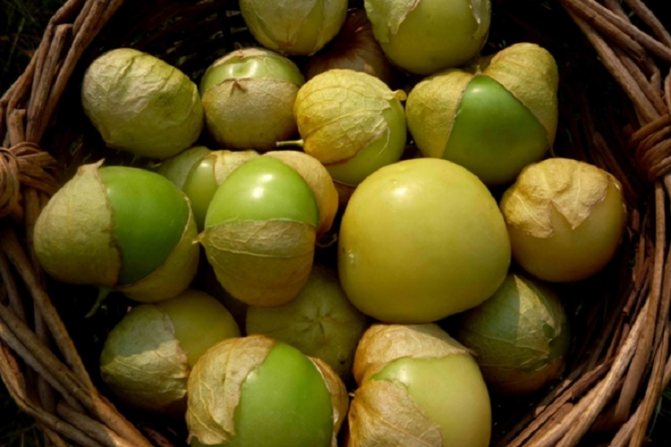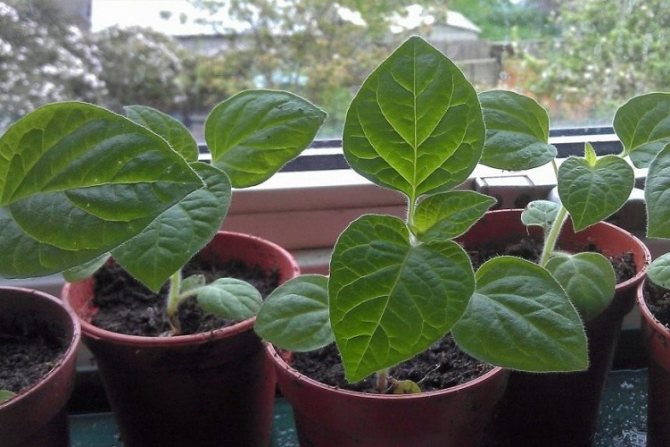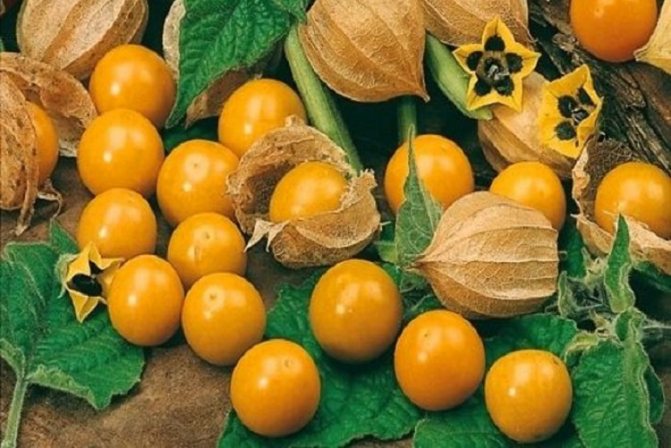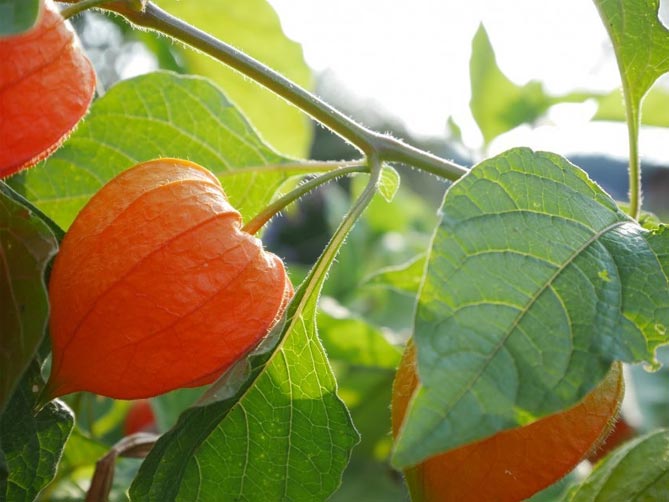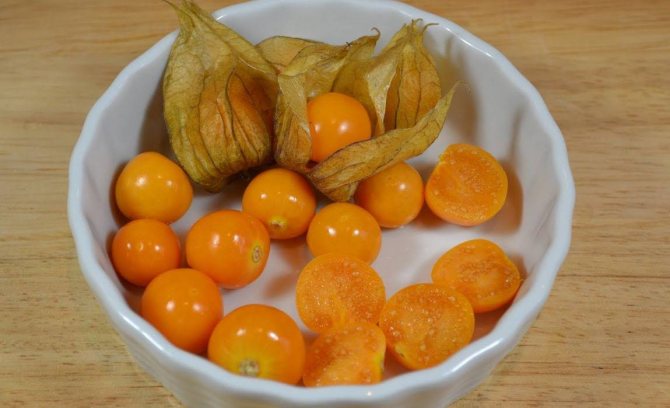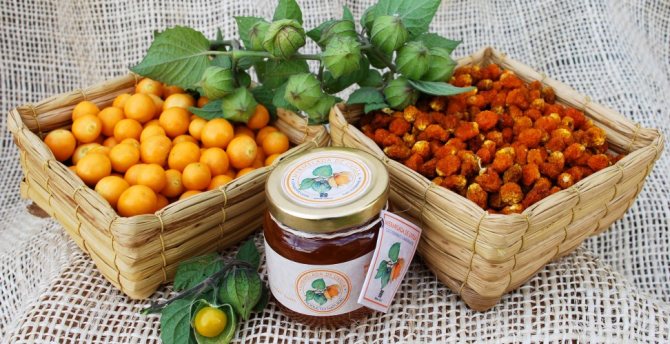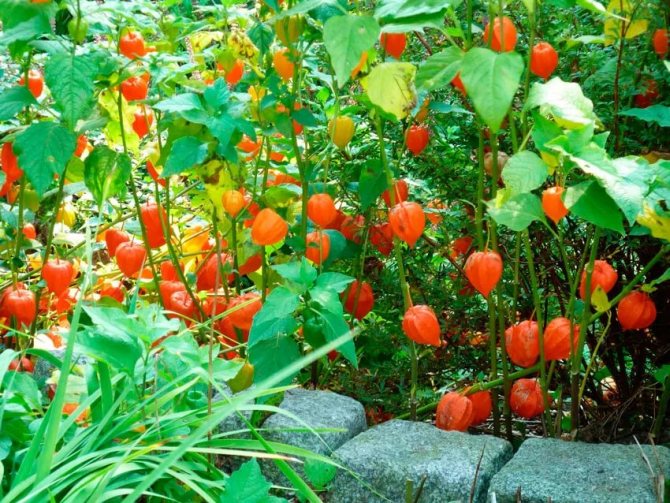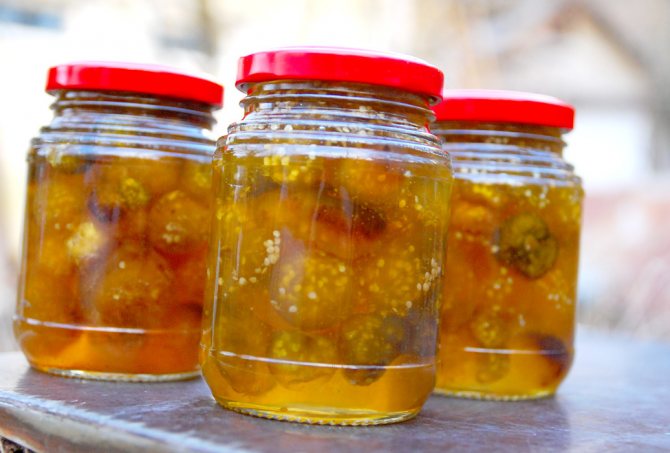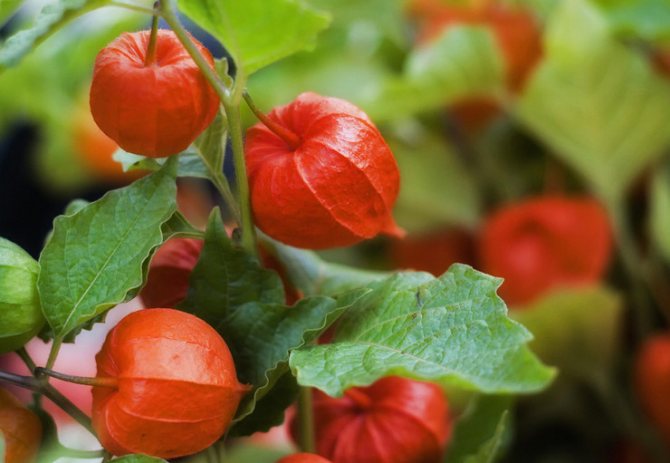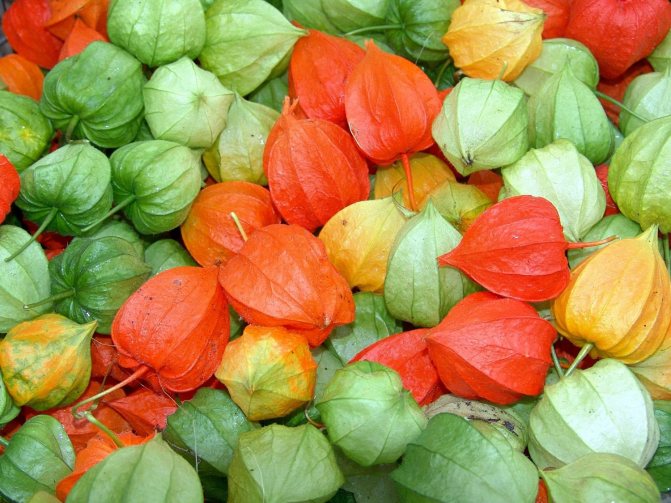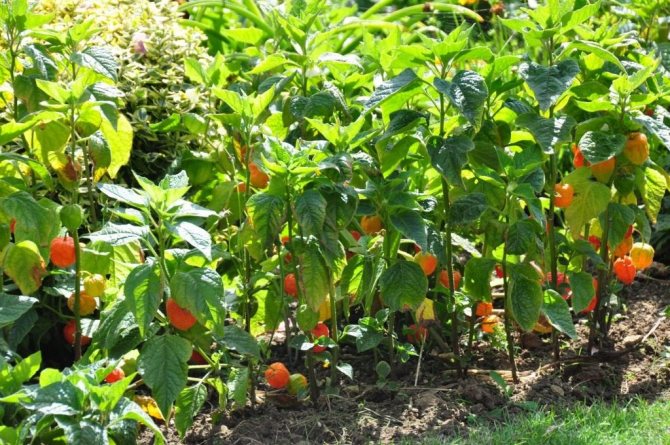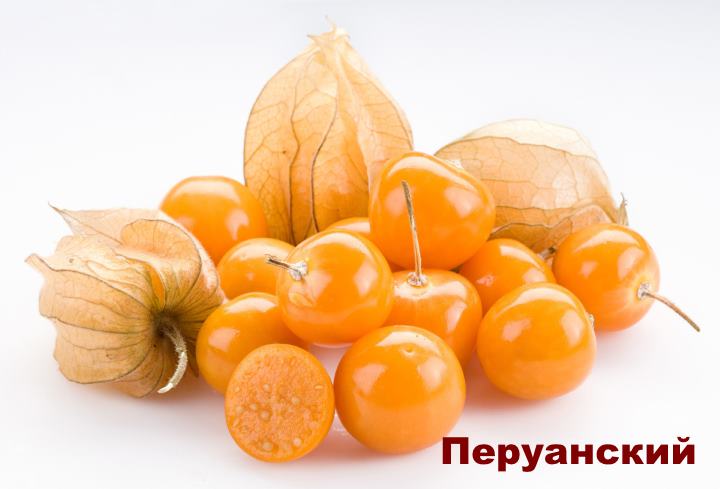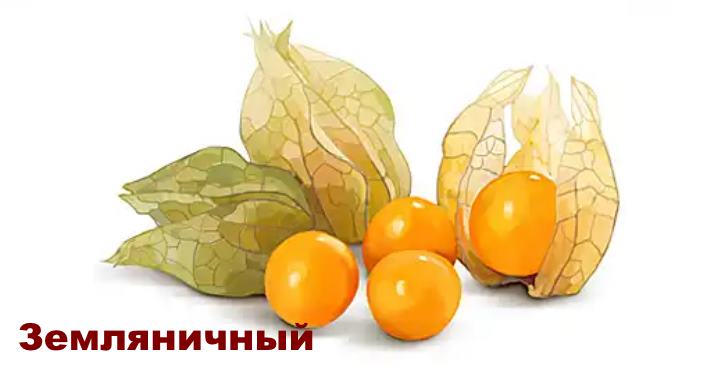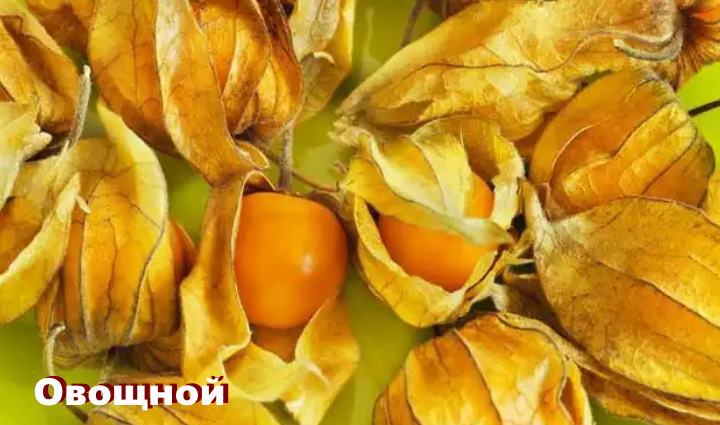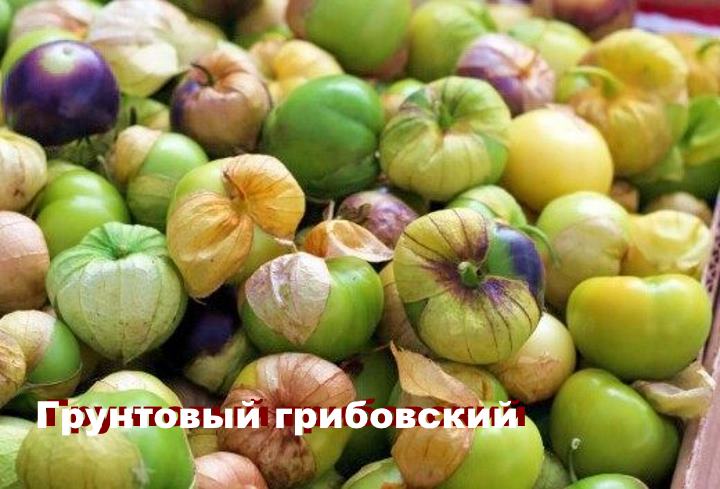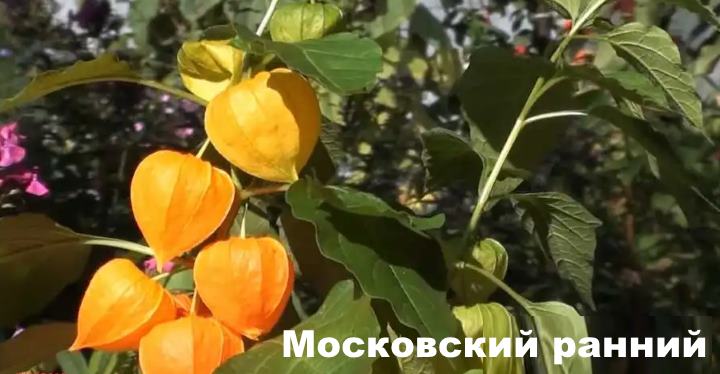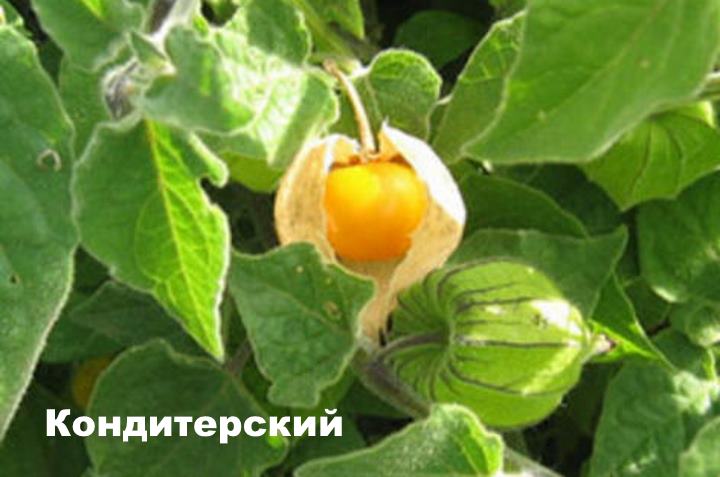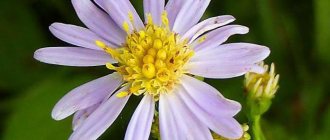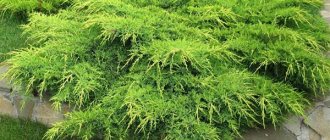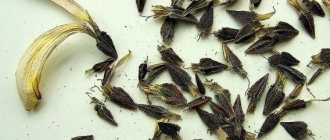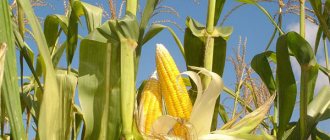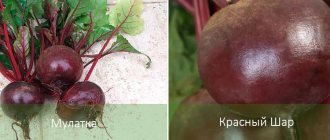Growing features
Planting and growing physalis is quite easy given its stamina. All types of plants, and there are 110 of them, are frost-resistant, tolerate drought well, a little worse - excess moisture. They can produce crops in shady places and in direct sunlight. Plant height ranges from 20 cm to 2 m (in tropical regions), and in the middle lane reaches 70-90 cm.
Both annual and perennial species are propagated by seeds. Their germination is high, can be stored after collection without loss of properties for 4 years... Gardeners prefer to plant physalis in open ground in the form of mature seedlings. To do this, the seeds are soaked in slightly salted water for 2-4 hours, the floating ones are removed, and those that have settled to the bottom are sown in a checkerboard pattern in a container with peaty soil. Disembarkation in a container can be carried out at the end of February at a constant temperature of at least + 15C. Watered with top watering, but not abundantly, so as not to give grounds for the reproduction of fungal diseases.
Seedlings from the container are transplanted into picking pots or strongly thinned out in the container when there are 2-3 leaves on the stems. When transplanting into dive tanks, the central root is trimmed.
The total duration of seedling growth in greenhouse conditions is up to 40 days. In April, physalis is planted in open ground, it is cared for when there are at least 5-7 leaves on the stems of the plant.
When choosing a landing site, a number of factors must be considered:
- Physalis cannot be grown from seeds on soils where tomatoes or potatoes were previously grown. Physalis also belongs to the nightshade family, and the soil after plants of the same genus will be scarce for it and, possibly, infected with dangerous diseases.
- Drainage. In stagnant soils, fungi develop rapidly, of which plants are most afraid.
- enough space. Physalis is a branchy plant that needs freedom at least 0.3 m in diameter from the root.
Choosing a home decorative flowering plant with red leaves
The soil where the seedlings dive should be dug deep, loosened. The pits should be sized to allow the roots to expand freely and be completely filled with water. The stem is covered with soil up to the level of the first lower leaves.
As for fertilizers, everything is suitable for physalis, except for organic matter, again because of parasites. Ash, peat or moderate fertilization with minerals are carried out for edible species before planting seedlings, and for ornamental species, one more top dressing can be carried out at the end of August, which will make it possible to continue flowering, keep the bolls in the best condition.
It is possible to use (for perennials) a vegetative reproduction method.In early spring, when the sprouts are just beginning to emerge from the ground, the rhizome is divided into several independent parts, added dropwise, watered.
Caring for physalis in the open field will not present problems if the rules for plowing, fertilizing and alternating crops are followed.
Useful properties of fruits
In the homeland of physalis, its fruits were used by locals in traditional medicine recipes. The Indians have empirically established that this plant able to drive bile, relieve pain and lower body temperature.
Today the fruits are used in traditional medicine. for the prevention of kidney stones and as a diuretic... In addition, with their help get rid of stomach colic.
Plant fruits rich in vitamin C and contain large amount of organic acids... According to these indicators, they surpass other fruits of other plants belonging to the Solanaceae family.
Physalis is very much appreciated by confectioners. The point is that it contains large amount of pectin... Confectioners use it to create various jelly-like fillings in candies. In addition, in the confectionery industry, citric acid is obtained from the fruits of this plant.
Finally, some types of physalis contain persistent organic dyesused in textile production.
Physalis photo
Required care
Physalis is not a plant that is costly in terms of the amount of effort required, but it does have some must-have items to care for. They can also include:
- Watering. Only a freshly planted seedling or an adult plant is needed during a period of persistent drought.
- Pinching the top of the plant. This measure promotes more abundant branching and flowering.
- Stealing is optional. Such a measure helps tomatoes to get the maximum number of fruits, but for physalis it is not of fundamental importance.
- Garter and brush for tall species. Physalis usually produces a large number of bolls, which causes the stems to tilt or even break. A garter to a stable support and cleaning of excess leaves will allow fruit versions to ripen faster, and decorative ones to look more advantageous on a flower bed.
- Autumn cleaning. Annual plants are completely uprooted and burned. For perennials, only the aerial part is cleaned, and the roots are left, slightly mulching.
- Collection of fruits. Ornamental physalis hide their fruits in boxes. To get seeds for the next year, the berries are soaked in water, then passed through a sieve. The seeds are dried. Edible physalis is processed immediately after harvest - dried, used in conservation. If the weather conditions were not conducive to ripening, then the pods together with the stems can be hung in a dry place so that they "reach".
Groundcover perennials blooming all summer in the garden
Ripening vegetable physalis and harvesting fruits
Most physalis fruits are formed on two branches of the first order and four branches of the second. On the rest of the shoots, both flowers and fruits will be single. Fruiting lasts until frost. The main signs of maturation will be:
- change in the color of the case and the fruit itself;
- drying and lightening of covers;
- shedding fruit.
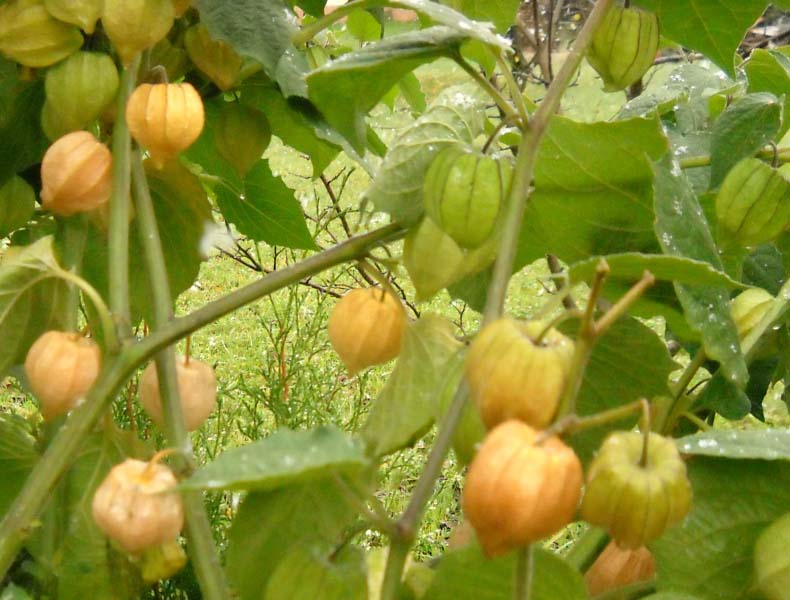
The fruits of the vegetable physalis ripen gradually, so the harvest is stretched from June to October.
If the fruits on the branches have reached a marketable size, but are not ripe, then the plant is pulled out together with the roots and hung for ripening in a dry room.
Ripe fruits are cleaned of covering covers and stored at temperatures ranging from +1 to +5 degrees. The shelf life of fresh physalis under the specified conditions can be up to 2 months.
Harvesting vegetable physalis seeds
If you want to collect your own physalis seeds, then it's easy to do:
- A large, selective fruit is cut, filled with water, preferably rainwater, and left for a day to soften.
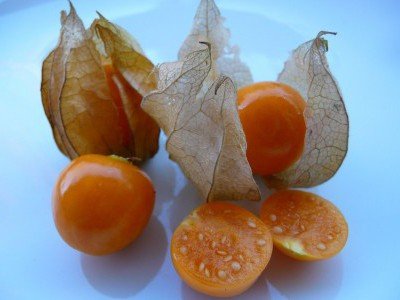

For harvesting seeds, you need to choose well-ripe fruits of vegetable physalis
- The mass is periodically mixed and then rubbed through a sieve.
- Selected seeds must be washed and dried
- Planting material is stored in a dry room in cloth or paper bags. Subject to the storage conditions, the seeds remain viable for three to four years.
The collected seeds do not always retain varietal characteristics, especially if several varieties of physalis grew on the site. This plant is easily cross-pollinated, but most often bushes from seeds obtained independently grow no worse than parental ones, and in many ways even surpass them.
Diseases and pests
Parasites that lead to a decrease in the activity of the development of physalis or its complete death include a number of fungi: mosaic, black leg, phytosporosis. The plant can also be affected by a bear, a wireworm.
They begin to fight diseases at the planting stage:
- deep plowing of the earth in autumn kills some of the harmful larvae;
- the soil before planting seedlings (for 2-4 days) is abundantly watered with a solution of potassium permanganate;
- seeds before planting are also soaked in a strong solution of potassium permanganate;
- if fungal diseases have shown great activity in development, then the affected physalis are removed from the flower bed and burned so as not to infect other plants;
- with minor manifestations of lesions, treatment with a Bordeaux mixture is used.
Planting seedlings in a plastic ring (a cut plastic bottle, with a total height of 15 cm, and the aerial part - 5-6 cm) will help prevent the defeat of the physalis roots by the bear.
In the case of a wireworm, the establishment of traps from rotten hay, boards, which are placed around the perimeter of the site in the morning, and on the second or third day they are burned along with the larvae that got there, will help.
How and when to collect berry physalis
The first crop appears 100 days after seed germination. Productivity is high: with proper care, up to 3 kg of berries can be harvested from 1 bush. Fruiting is long, lasts until the first frost.
The crop is harvested on a sunny, dry day. You can determine the degree of maturity by the bright color of the fruit and the drying of the leaves of the fruit capsule. It is undesirable to delay the collection of fruits. Ripe berries can begin to crumble and rot. And it is also necessary to be in time before the first frost, since such fruits are not subject to long-term storage.
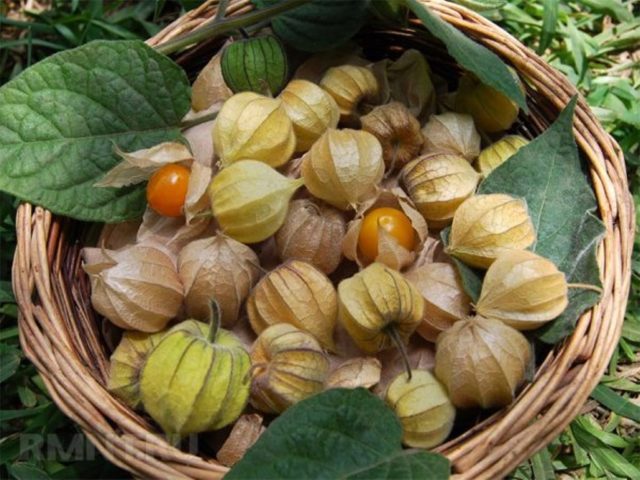

Nutritional and medicinal properties
Edible plant varieties - Raisin, Florida, Peruvian, Pineapple, Strawberry, Columbus, Kudesnik - are rich in pectin, fructose, sucrose, vitamins. These fruits are eaten fresh, dried, pickled, in jams and tinctures.
It is believed that all types of physalis (but to varying degrees) have stone-removing properties, so they are recommended to be used with caution by those who have problems of this nature with the kidneys or bile. At the same time, physalis will be a good prevention of these diseases.
Kalanchoe Kalandiva: care and cultivation at home
Physalis can be considered a valuable crop by the amount of nutrients in its composition (per 100 g of product):
- fructose - 2.1-3.7 g;
- acid - 0.7 - 1.3 g;
- vitamin C - 17-28 mg.
Ornamental species cannot be eaten, but in small quantities due to the solanine substance they act as an anesthetic, hemostatic agent. Physalis decoctions promote rapid recovery from inflammatory processes in the digestive, respiratory, and genitourinary systems. It is important to observe the dosage rates when taking, since an overdose threatens a number of neurological problems and even respiratory arrest.
Vegetable varieties are used even in fresh salads, in the preparation of pickles, marinades.The most popular types are Gribovsky, Korolek, Confectionery. Some taste like sour tomatoes, while others taste like strawberries, pineapple, or even gooseberries.
It can be stored dry for more than a year. Drying itself is carried out either in special dryers for fruits, or in a conventional oven at a temperature of 40-50 C. The duration of drying depends on the variety, but on average it takes at least 6 hours.
Physalis belongs to a rare type of vegetables that have the properties of gelatin, therefore it is used in the manufacture of various kinds of confectionery and sauces.
As an example of delicious and proven recipes with physalis, jam from it and canapes are offered.
- The jam is prepared for several days, because for the ideal taste and consistency, physalis is boiled without boiling, and completely cooled before the next heating. For ½ kg of berry physalis take 1 lemon, 1 cinnamon stick, 400 g of sugar and 1.5 tbsp. water. In a saucepan over low heat, dissolve sugar in water, add a cinnamon stick and 4-5 slices of pitted lemon. All are boiled. Thoroughly washed physalis is thrown into a sweet liquid, kept on fire, without boiling, for 20-25 minutes. Stir gently to keep the berries intact. After turning off, take out the cinnamon, cool completely. Heat for 20 minutes. another 5-6 times (obtained within 2-3 days), until the jam thickens enough. You can use jam and berries from it as a decoration for baking, desserts, or as an independent delicacy.
- Canapes. It's not about the usual bread cakes with a bright decoration, but about a dish of celery, cheese and physalis. Petiole celery is cut into squares, rhombuses, or any other convenient shape. Cream cheese is ground with papaya and lemon juice, salt, black pepper, ground in a blender. Using a cooking syringe or teaspoon, gently spread the mixture over the celery. Pickled physalis or fresh berries are placed on top of the cheese.
The names of swamp plants and flowers that grow in the swamp
It is worth noting that physalis is used as decorations for dishes and together with boxes, but then it is better not to eat it, since the sticky (and harmful) substances from it were not washed off.
Description of the variety
Edible physalis is usually subdivided into two large varieties: vegetable physalis and berry. The berry variety, the most popular of which is the strawberry physalis, can grow everywhere. It is consumed not only fresh, but also dried, used to make compotes, preserves and even sweets. Berry physalis varieties are distinguished by a sweet or sour-sweet taste, they are medium-sized, most often amber-yellow in color.
Vegetable physalis, unlike berry, have larger fruits (up to 80 g). They can have a variety of colors: yellow, green and even purple. The variety is more productive, makes less demands on heat and light.
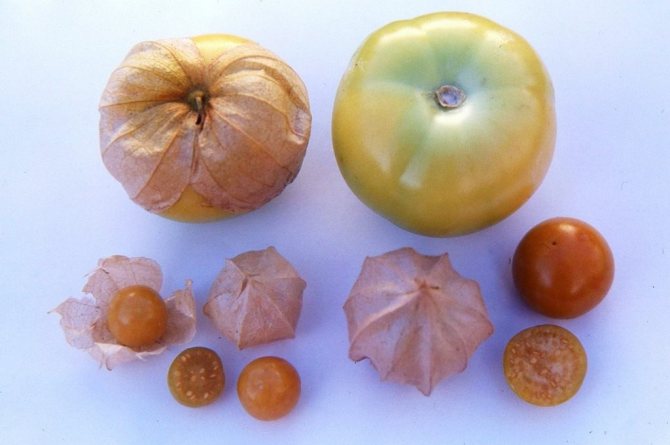

The photo in the top row shows the fruits of vegetable physalis, and in the bottom row - berry
Vegetable physalis is an annual with large, fragrant, yellow or bright orange flowers that resemble small bells. One plant of this culture can give up to 200 fruits. There are tall (about 1 m) and undersized, almost creeping on the ground, varieties. Physalis fruit has a rounded shape and is formed in an overgrown calyx, which covers it like a cover.
It is the berry sheath that is responsible for protecting it from frost, pests and many diseases, and also contributes to long-term storage.
Photo gallery: appearance of vegetable physalis
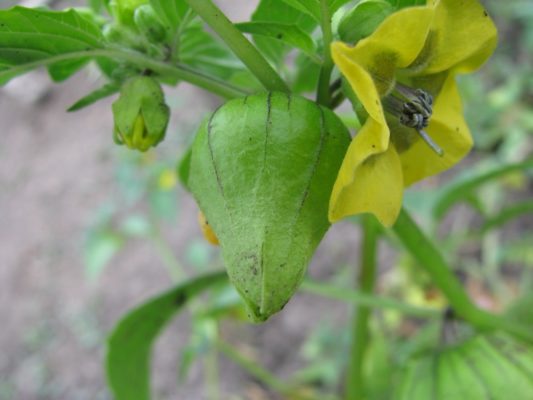

Physalis fruit is enclosed in a green box, which is formed by accrete sepals
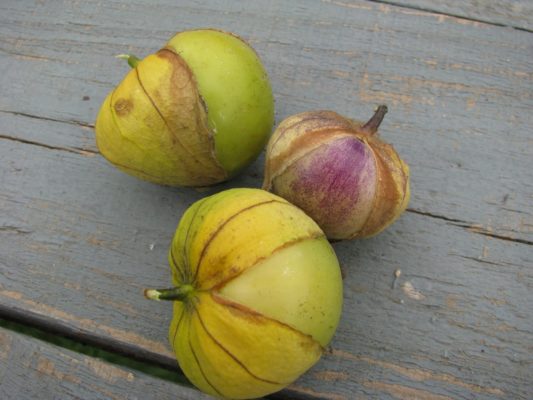

Harvesting of vegetable physalis begins in June and ends in late autumn
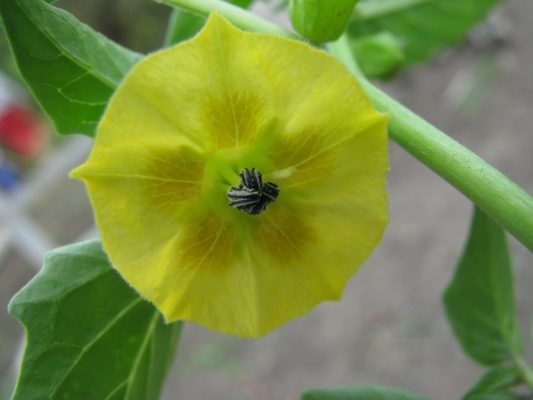

Physalis flowers can be yellow, orange, less often white, sometimes lilac.
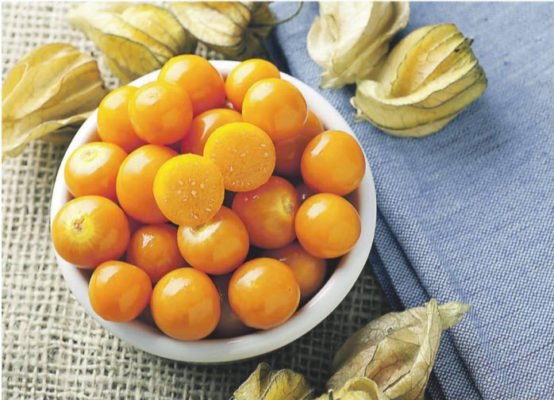

Physalis fruit is a fleshy berry of yellow-green or yellow-orange color, similar to a tomato, tastes from very pleasant to pungent bitter
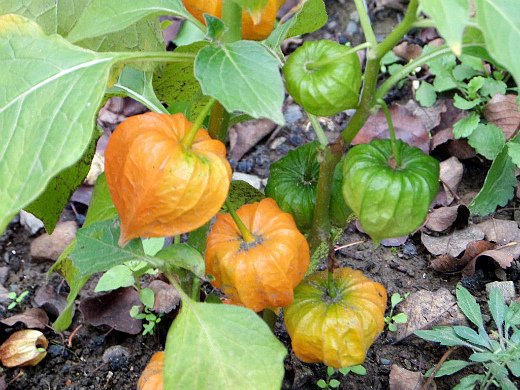

When ripe, the color of the case, in which the physalis fruit is enclosed, changes to a brighter
Growing regions and crop features
Central America is considered the birthplace of vegetable physalis. This vegetable is especially fond of the inhabitants of Mexico. They widely use its fruits in the preparation of hot sauces and salads.
The culture grows well not only in the southern regions, but also in the northern regions of the Non-Black Earth Region, and other areas with short daylight hours. Physalis is the most cold-resistant representative of the nightshade family. Its seedlings are able to withstand a drop in temperature to -3 degrees, and a powerful root system helps the crop fight drought. The vegetable is unpretentious, resistant to diseases, including phytophthora, and pests, ripens quite early and is well stored.
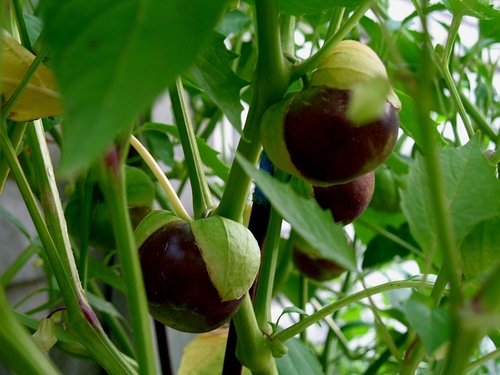

Mexican physalis is a typical vegetable crop, close to tomato in its biological properties, but more cold-resistant, drought-resistant, less demanding on light
Physalis gardeners note that working with this crop always leaves only the most pleasant impressions.
Composition, useful properties and use of vegetable physalis
Physalis vegetables are rich in carbohydrates, glucose and fructose. They contain many active substances: tannin, polyphenol, fizalin, cryptoxanin, as well as a large amount of organic acids and vitamins. Lycopene, a strong antioxidant, which is used in medicine to prevent cancer, gives the fruit a bright color. Nutritionists recommend including vegetable physalis in your diet due to the presence of pectin, a substance that helps cleanse the body of toxins, toxins, cholesterol and heavy metals.
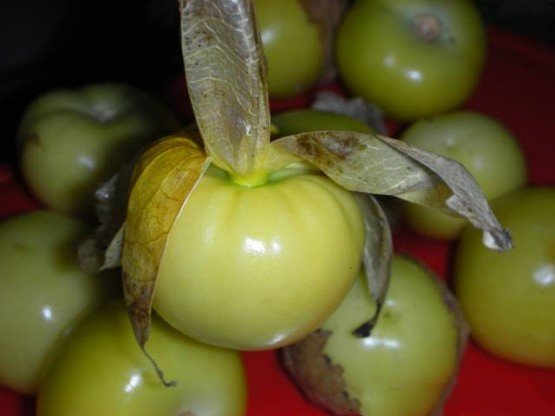

100 grams of the berries of this plant contain only 32 kilocalories, that is, almost two times less than grapes and mangoes.
Traditional medicine notes the anti-inflammatory, hemostatic, analgesic, diuretic and choleretic effects of physalis fruits. Official medicine advises people with diabetes, hypertension, cholecystitis and even stomach ulcers to use the vegetable, as well as a general tonic.
You should know that the aerial part of the plant, as well as the fruit sheaths, contain a large amount of alkaloids that can have a negative effect on the human body.
The most actively used vegetable physalis in cooking:
- Physalis gives a delicate taste to vegetable stews and garnishes;
- it is recommended to add it to soups, borscht and sauces;
- from baked physalis, not only excellent caviar is obtained, but also filling for pies;
- those housewives who tried to pickle this vegetable note its similarity to canned tomatoes;
- gourmets claim that physalis jam resembles fig jam.
True, many gardeners note the not very pleasant taste of even ripe raw fruits.
Photo gallery: culinary delicacies from physalis
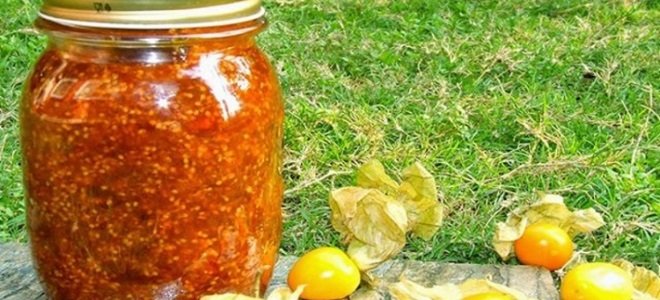

Physalis caviar can be served immediately, or rolled up for the winter
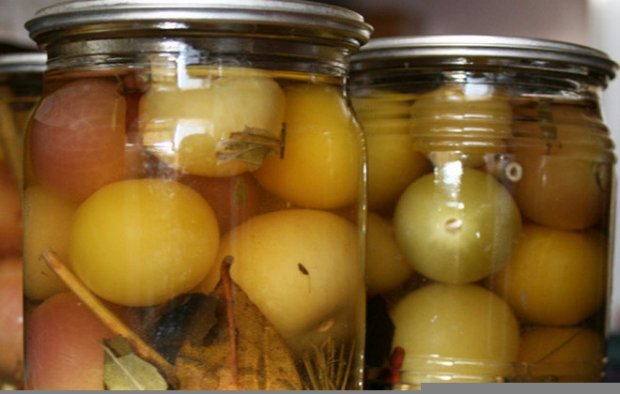

Physalis marinated for the winter resembles pickled green tomatoes in taste, only the taste of physalis is slightly softer
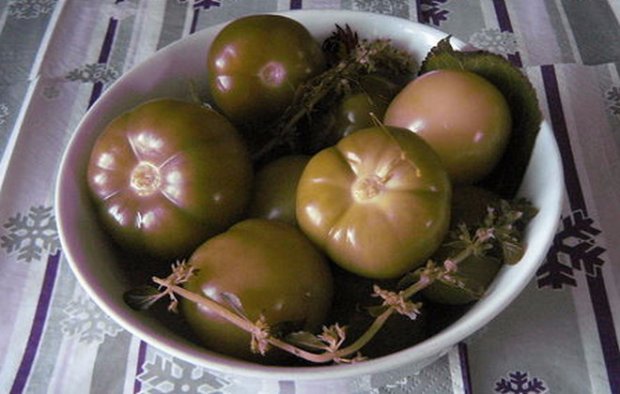

Before soaking, the washed physalis fruits should be scalded with boiling water, and then dipped in cold water
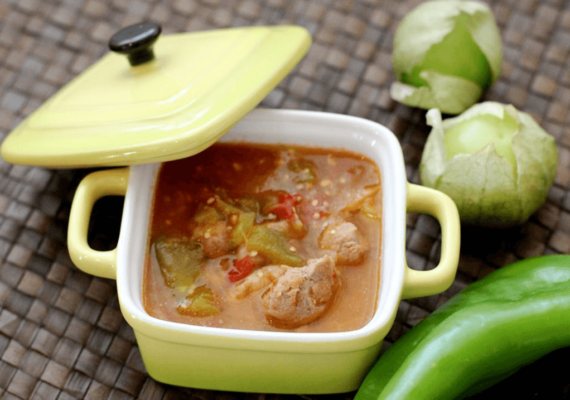

Physalis is prepared not only with paprika, tomatoes and coriander, it goes well with meat, giving it a special aroma and piquant taste.
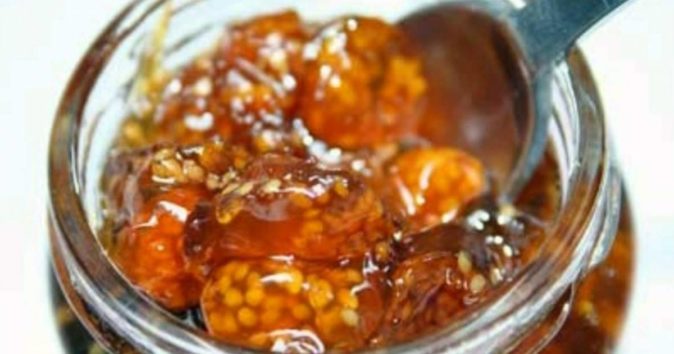

For cooking jam, vegetable physalis is not only washed, but also blanched in hot water to remove bitterness and slimy plaque
Video: vegetable physalis jam
Use in decor
Physalis's acceptability as a food product has not yet found adherents in many countries, although in Mexico and South America the plant is used everywhere.
In the middle lane, physalis is most loved as an ornamental plant due to the long flowering period and storage of bright bolls.
Low-growing varieties are planted in pots, form the crown of a bush in rounded shapes and are used to decorate terraces, gazebos, or even the entrance to a house. Hanging pots with physalis look especially impressive, the stems of which were allowed to fall.
Wreaths are made from stems with boxes to decorate doors. The combination of physalis and branches of evergreens (pine, spruce, thuja) intertwined with cereal grasses or real wheat is considered especially beautiful.
You can use Chinese lanterns (as the plant is also called) in combination with autumn flowers or as an independent decoration of candlesticks, circular chandeliers. There is no specific smell or negative effect on a person in a room with a plant.
What is Physalis?
The homeland of this plant is South America. It was actively cultivated by the aborigines. Thanks to them, it moved to North America. The plant got to Europe and Asia together with travelers. It reached Russia at the end of the 19th century as a domesticated plant.
Physalis is a typical perennial. More than 110 species of this plant grow in nature, and the vast majority of them are wild-growing. Only 4 species are considered domesticated. Moreover, only 2 of them have taken root in our country: vegetable and strawberry.
Vegetable grows up to 1 meter in height. Its fruits are green and weigh no more than 50 g. They are excellent for preservation, but they are not eaten raw.
The best varieties of vegetable physalis are:
- Kinglet.
- Moscow early.
- Large-fruited.
- Gribovsky soil.
Strawberry physalis is significantly lower than vegetable. Its height does not exceed 70 cm. The average height of the bush is 50 cm. It branches very strongly and is able to creep along the ground.
The fruits of strawberry physalis are much smaller than the fruits of vegetable. The size difference can be seen in the photo. They are yellow in color. On average, one berry weighs no more than 10 g. From the fruits of strawberry physalis, jam is usually cooked and raisins with an unusual taste are made.
Also in our country you can often find decorative physalis. Summer residents love to plant this plant to decorate their plots, because its bright red and orange fruits, similar to Chinese paper lanterns, look great on flower beds. Examples of the use of physalis in landscape design can be seen in the photo. Physalis is grown at home as an annual plant. For this reason, it is propagated mainly by seeds and cuttings.
Pre-sowing preparation
Seed treatment
Physalis seeds are quite small, so it's not easy to immediately figure out which ones are the best. To reject dummy seeds that do not germinate, we carry out the selection of seed at home using a solution of kitchen salt. A couple of tablespoons of salt (tea, without a slide) are poured into a glass of water and stirred thoroughly until completely dissolved. Pour the seeds into a glass and stir with a spoon.
Those that have sunk to the bottom are the best seed, and those that have floated to the surface need to be removed. Carefully rinse the best seeds with running water and dry. Before the sowing itself, we direct a weak solution of potassium permanganate and place them there for 20 minutes. A fungicide solution is also effective for disinfecting seeds. Fitosporin, Vitaros, Maxim are ideal for this purpose.
Place and soil for cultivation
To grow vegetable physalis, we choose illuminated areas with light and fertile soil in the country. We categorically exclude shaded and low-lying areas for planting. In the spring we carry out a deep digging of the earth.To enrich the soil, we add rotted manure and crushed wood ash to it. Excellent predecessors of physalis are cabbage and cucumbers. It is unacceptable to plant this plant after any types of nightshade crops, which include the physalis itself. Close proximity to them is also undesirable, since they all suffer from the same diseases. To ensure the friendly emergence of seedlings, we place the seed material for 12 hours in an aqueous solution of Epin (a couple of drops per 100 ml).
Outdoor care
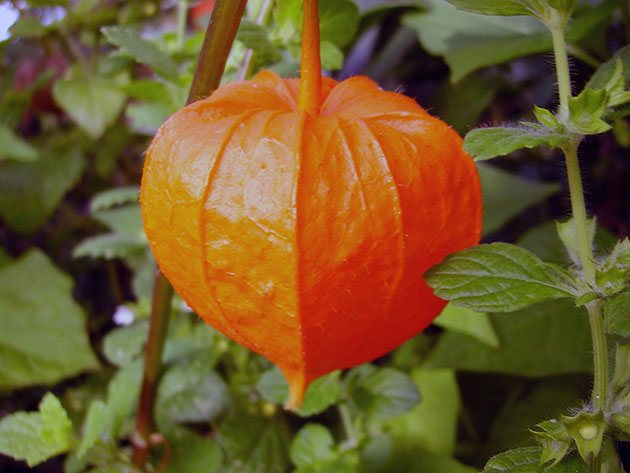

Physalis, growing and caring for the crop, the process is not laborious. During growth, the plant needs periodic watering and subsequent loosening of the soil. Fertilizing with organic substances, such as mullein or chicken droppings, will not be superfluous. Fertilizers must be applied strictly after watering. Planting and caring for the plant also provides for hilling bushes in cold and damp summers. It is worth noting that you do not need to cut and pinch the bushes, since the fruits develop precisely in the branches, therefore, the more the bush branches, the richer the harvest awaits you.
More details about leaving in the video:
Popular varieties of strawberry physalis
Strawberry Physalis is a relatively new and rare plant for Russian gardens, so it has few varieties. In the conditions of the middle lane, the variety Zolotaya Rossii (VNIISSOK selection) and the varieties Pineapple, Dessertny and Strawberry from the "Classic" series from agro have proven themselves well.
Large-fruited (with berries weighing up to 50-80 grams) varieties of physalis with tempting confectionery names belong to another botanical species - Mexican physalis, which differs from strawberry by the absence of pubescence on the stems and leaves and a tighter adherence of the caps to the berries.
In my personal experience, no special fundamental differences between different varieties of strawberry physalis have been noticed. And the Mexican is a completely different plant.
Growing physalis from seeds
Sowing physalis
In a warm area, physalis seeds are sown directly into the ground, since the plant is cold-resistant, early ripening and fruitful, and it is enough to sow Physalis once, and then it will multiply by self-seeding - you will only have to thin out the seedlings. Since physalis seeds suddenly lose their germination after 4 years, soak them in a 5% salt solution before sowing and after a while remove the floating seeds that are not useful to you, and wash the settled ones and pickle for half an hour in a dark pink solution of potassium permanganate, then rinse and dry.
- Hydrangea: an oriental beauty who loves water
Physalis is sown in April or early May sparsely in the grooves, keeping an interval of about 30 cm between rows.When seedlings appear, they are thinned out so that the distance between the seedlings is about 25 cm. Those seedlings that had to be pulled out can be transplanted to another place - they will take root perfectly, although they will begin to bear fruit a little later. Physalis can be sown before winter, in October.
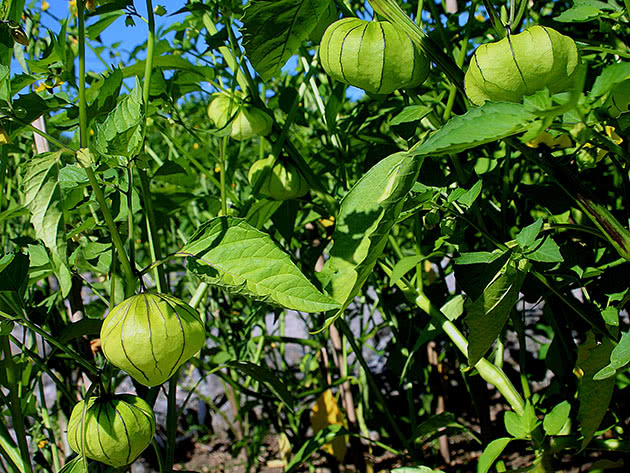

Physalis seedling care
In the middle lane, physalis is grown in seedlings, especially since it allows you to get fruits earlier than when sowing seeds in the ground. Physalis seeds are sown for seedlings about a month and a half before planting in the ground in separate containers with a volume of 0.5 liters, if there is no desire to tinker with a pick, or in seedling boxes according to the 6x8 scheme - before planting in the ground, it remains only to divide the seedlings into bushes. As a pre-sowing treatment, the seeds are kept for 30 minutes in a strong solution of potassium permanganate.
Physalis is germinated at a temperature of about 20 ºC, and then sprouts can appear in a week. At a lower germination temperature, you will have to wait a month.
Make sure that the moisture content of the soil and air is not too high, since under such conditions there is a risk of disease of seedlings with a black leg, therefore, caring for a physalis flower at this stage includes regular ventilation of the room, provided that they are reliably protected from drafts. If, with proper care and normal lighting (physalis seedlings need a bright diffused light), the seedlings grow slowly or painfully stretch out, it is necessary to add a solution of bird droppings to the soil - 1 part of fertilizer to 20 parts of water at the rate of half a bucket per 1 m2, and then spill the soil with water in avoid burns.
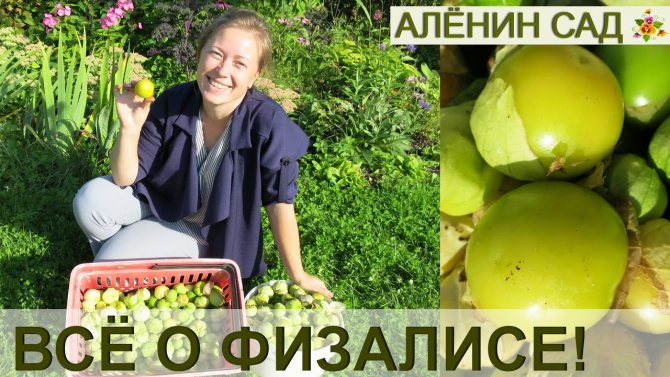

Physalis pick
Those who have sown physalis in a seedling box densely will have to dive into separate cups when the seedlings have two true leaves, so that when planting, as little as possible, injure the root system of the physalis, which grows very quickly. If you sowed the seeds immediately in separate cups, then you do not have to dive the seedlings - you can plant them directly in the open ground within the time period established for the growing of seedlings.
Physalis care after sowing seedlings
As the seedlings grow, it is recommended to feed them every 14-17 days with an easily soluble fertilizer for seedlings (such as Fertiki, Agricola or Solution).
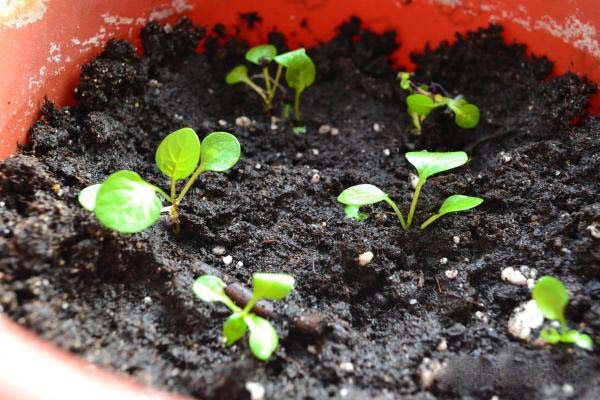

It is equally important to periodically turn the seedlings towards the sun for more even growth.
Picking
Physalis seedlings dive in the phase of 2-3 true leaves.
It is better and easier to take the same soil mixture as when sowing seedlings, but with half the sand. To optimize the process, 2 tbsp is simply poured onto 10 liters of soil. l of a complete nitrogen-phosphorus-potassium mineral fertilizer (such as nitroammofoska).
Next, the planting containers are filled with a substrate and lightly tamped.
Then pits are made of such a size that the seedlings can be buried to the cotyledonous leaves.
Excessively long roots should be trimmed and shortened slightly. Fear not, this procedure only stimulates the formation of even stronger roots that can draw moisture from the depth of the pot.
Reproduction
Physalis vegetable grows very quickly with a powerful root system. Therefore, when growing it, special limiters are often used.
The easiest way to reproduce is to dig up young shoots with roots. Cuttings are also used for these purposes. The procedure is best done at the end of July. Cut off the top of the shoot with 3 formed internodes. The cuttings are placed halfway into the prepared soil and moistened. For faster rooting, the seedlings are covered with foil. On hot days, they require special care. They need to be shaded and watered more often. As soon as the shoot is fully matured and rooted, the shelter can be removed.
Physalis is a berry or vegetable
Physalis is a herbaceous plant that grows up to 1.2 m in height. There are perennial and biennial varieties. The main feature is the fruit, which is in an unusual box that resembles a Chinese lantern. The capsule is a sepals that have grown together. When ripe, it changes its color from green to orange or yellow, less often lilac or white.
The fruit is a berry that looks like a tomato. When mature, it reaches a yellow or orange color. The pulp is firm and fleshy with small seeds. The taste is varied. They range from sweet to neutral with a hint of bitterness.
Wild representatives of physalis can be found in forests, ravines, on the edges, in the form of a weed in garden plots.
Attention! The most common decorative physalis or immortelle. Its berries are unfit for human consumption and are considered poisonous.
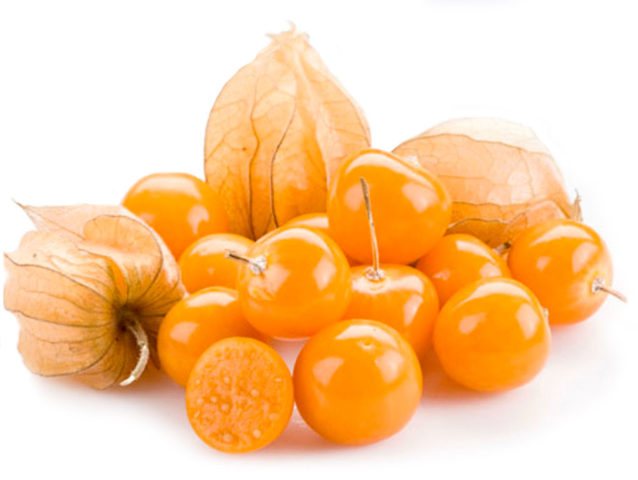

Physalis species diversity is represented by the following varieties:
- berry;
- vegetable;
- decorative.
Harvesting
With proper care, the vegetable physalis, first of all, ripens the lower berries. They may crumble, but this does not affect their taste. They are collected and used for their intended purpose.
Fruits can be picked unripe and left to ripen. For long-term preservation of the crop, it is necessary to remove it in a dark place with a temperature of no more than +5 degrees.
The collection is carried out before the onset of cold weather, in dry weather. For long-term storage of the crop, the fruits are plucked together with the box. The wax coating protects the berry from damage. The degree of ripening of the vegetable physalis can be determined by the cap. When it begins to dry out and change color, you can prepare for harvest.
Very often, by the end of September, many unripe fruits remain on the bushes. You can dig up the plant and hang it in the back room until they are fully ripe.
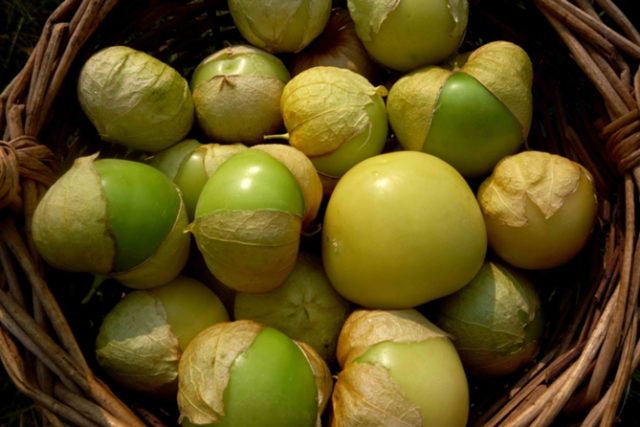

Ordinary
Physalis ordinary (Physalis alkekengi) is a perennial plant with valuable decorative qualities. Also has the names of the dog cherry, sackcloth, sleepy grass.
Description of the species
Botanical characteristics
Under favorable conditions, the plant reaches a height of 1 meter. It is a perennial with a strongly growing rhizome. Single shoots sprout from the rhizome. They grow upright at first, but tend to lie down with age.
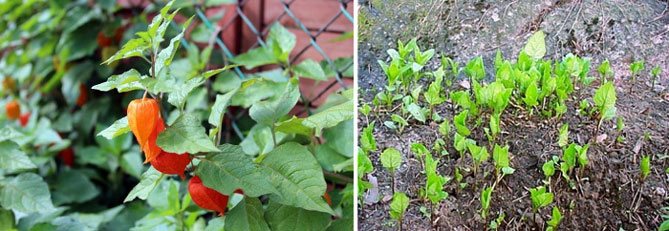

The shoots are covered with foliage. As the seeds mature, the lower leaves turn yellow and dry, and the shoots at the base are slightly woody. The leaves are triangular, sometimes serrated.
Off-white, showy flowers on hanging petioles appear in the corners of the leaves in spring. Flowers appear in late May - early June. After pollination, the petals fall off and the flower bowl develops rapidly, forming a swollen sac surrounding the spherical fruit inside. First, the bag is green. As the fruit ripens, the color of the sac changes to red.
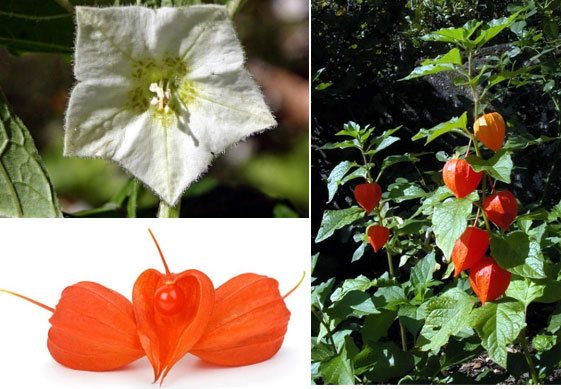

Inside the flower bowl, small berry-like fruits are formed, surrounded by a spectacular orange-red shell. The pouches acquire a bright color in late August - early September. The fruit is edible, two-chambered, cherry-sized red berry. The fruits decorate the plant until the first frost, forming an aesthetic decoration until late autumn.
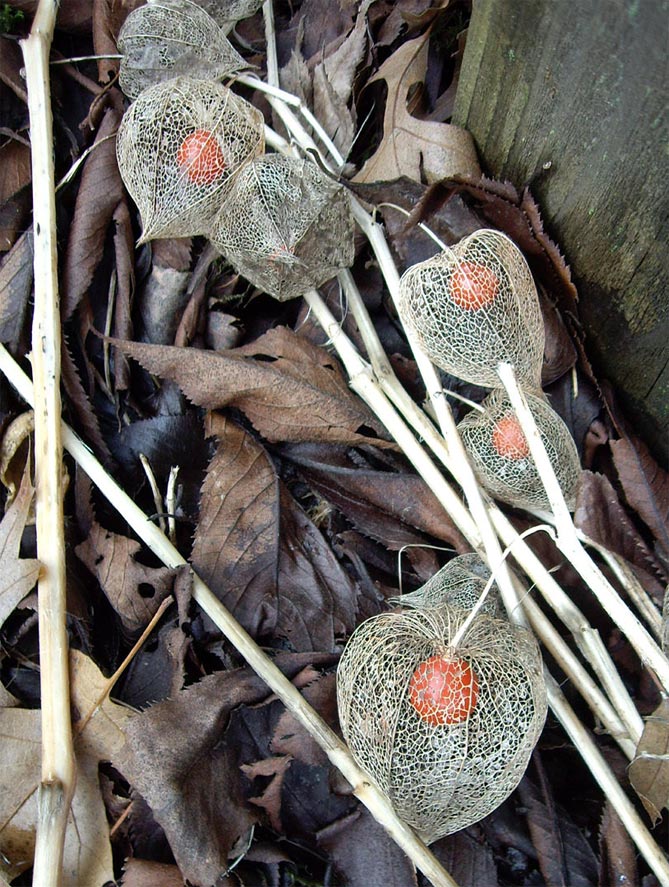

Origin
Determining the exact place of origin is very difficult, the plant has been cultivated for millennia, spreading in gardens around the world. The probable natural place of origin of the plant is Asia, especially the central-western region.
Height
Physalis ordinary has 2 subspecies:
- Physalis alkekengi var. alkekengi grows up to 60 cm in height;
- Physalis alkekengi var. Franchetii or Franchet - reaches a height of 100 cm, has more fruits on the stem.
Requirements and care
Attention! Anyone who loves this plant and has a small garden should think twice before planting the plant. The plant grows strongly and is difficult to remove. It will take about two years to get rid of it. Removing physalis is like fighting grass. Even a piece of rhizome left will give new shoots the next year.
Soil requirements, positions
- Common physalis grows well in sunny and semi-shady places.
- Prefers high pH soils.
- Dislikes heavy and wet soils.
If, despite the lack of a large enough space for a plant, you need to plant it, it is better to try growing physalis in a pot planted in the ground. Then it does not grow so. In the flower pot there should be no drainage hole, through this hole the plant will germinate into the soil and spread over the site as if it were planted in the ground. The rhizome is located in the ground at a depth of 50 cm, so there can be no question of other means of protection. If all pots have holes, place them on the asphalt. We will not achieve large plants, but this is sufficient for decorative purposes.
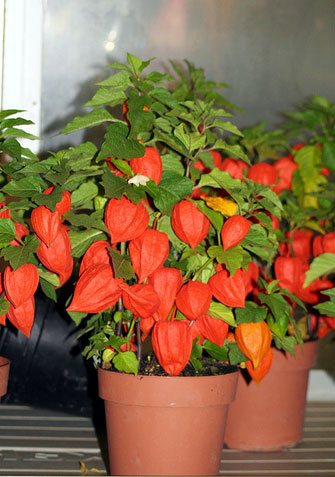

If you plant physalis in open ground, you should choose a place where it will not only grow, but will also be covered with more attractive plants for most of the year. The sackcloth looks beautiful only in autumn.
Drying
For drying, cut the plants when most of the bags are painted. Remove the leaves and dry the plants in a dark room to keep the bellows color from fading.
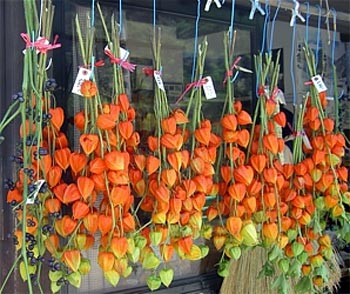

Frost resistance
In the presence of snow cover, the plant is completely frost-resistant, although the young spring growth can be damaged by late frosts.
Reproduction
- The easiest way to propagate Physalis vulgaris is to cut off a piece of rhizome from the mother plant. Division should be done in the spring when the shoots are small.
- You can propagate a plant from seeds. Stratification is required for uniformity and germination rates.


Diseases and pests
The plant practically does not suffer from diseases or pests to the extent that requires intervention.
Application
Fruit berries are edible and have medicinal properties:
- anti-inflammatory.
- cleansing (diuretic),
- regulate metabolism,
- tinctures and water extracts from the baskets are used for medicinal purposes.
Berries and canned food made from them are a tasty addition to various dishes.
Attention: you can only harvest ripe physalis fruits that have acquired an intense orange color. Unripe (green) fruits are poisonous.
Photo. Unripe physalis ordinary
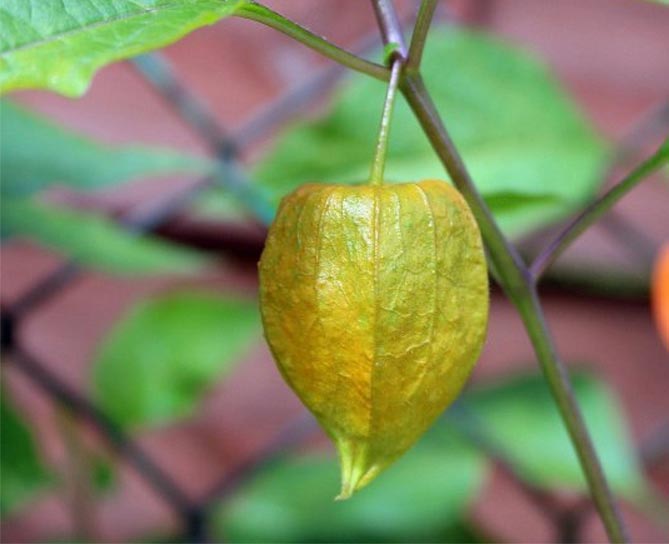

Physalis ordinary is used to create dry bouquets. Green bouquets with leaves look beautiful.
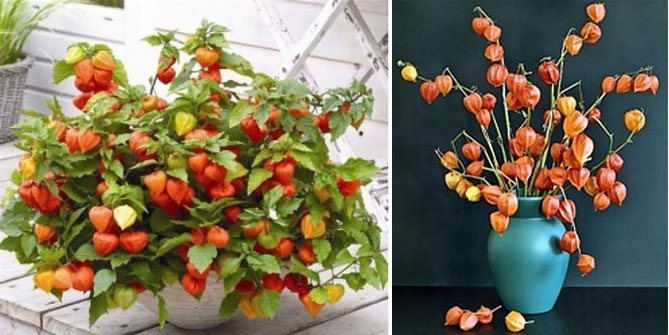

Peruvian
Peruvian physalis (Physalis peruviana) - despite the name, it is grown mainly in Chile and Venezuela. It is a food plant reaching a height of 1 meter. In bright yellow flower rosettes, sour, orange-yellow edible fruits are formed, which are harvested before early autumn (necessarily before the onset of the first frost). The dried fruit of Peruvian physalis is often compared to raisins. The seed coat is not as decorative as in the Common species, but the berries are more pronounced.
Harvesting. The Peruvian physalis crop is eaten when the fruits are fully ripe - they have an intense orange color. You can wait until they fall, because the dry bag protects the crop well, and if the substrate moisture is not high, the fruit can remain intact even for several days.
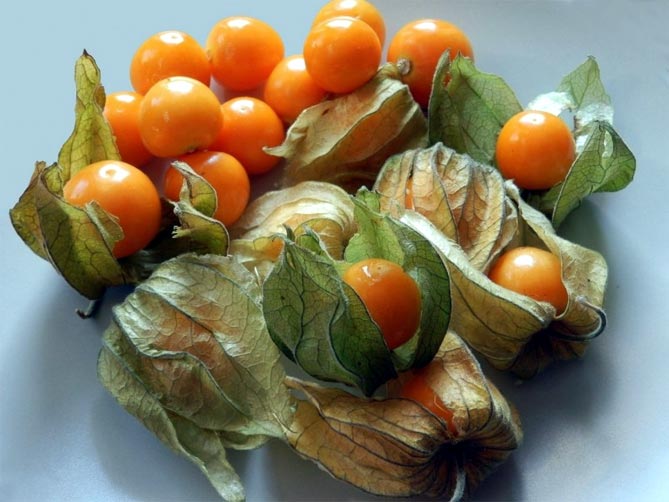

1. Seven Secrets of Success:
| 1. Growing temperature: keep physalis throughout the year at a normal room temperature ranging from 16 to 25 ° C, in winter the room temperature should not fall below 10 ° C. |
| 2. Lighting: well-lit place without direct sunlight during daytime or partial shade. Physalis can take sun baths only in the morning or in the evening, 3-4 hours daily. |
| 3. Watering and humidity: we water regularly in the warm season, thoroughly dry the top layer of the soil in the winter months, and when kept in a cool room, we reduce the frequency of watering to a minimum, the air humidity is high. |
| 4. Pruning: The stems of young plants are pinched to form lateral shoots. |
| 5. Priming: tolerates a wide pH range, rather poor soil with excellent drainage is selected for cultivation. |
| 6. Top dressing: in spring and summer we feed monthly with organic or mineral fertilizers. In the middle of autumn, we stop feeding and resume them only in the spring, with the appearance of the first young leaves. |
| 7. Reproduction: sowing seeds in late winter - early spring, stem cuttings in spring and summer, separating basal offspring, dividing large plants when transplanting in spring and summer. |
Botanical name. Physalis.
Family. Solanaceae.
Origin. It is found in the wild in both Americas, Eurasia.
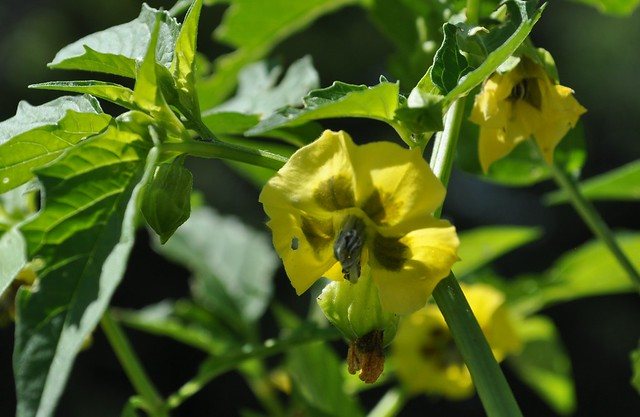

Description. Perennial herbaceous plants with a height of 40 cm to 3 m, depending on the species. Sometimes there are annual species, but they are in the minority.
Stems erect, rigid, rather thin, slightly branched.
Leaves emerald green, cordate, arranged in opposite pairs, on thin, long, slightly pubescent petioles. The leaf blades have a pleasant silvery pubescence and are slightly recessed into the surface, numerous veins. The edges of the sheet plates can be either solid or serrated. The leaves reach 6 - 15 cm in length.
Flowers bell-shaped, solitary, axillary, appear in the summer months.
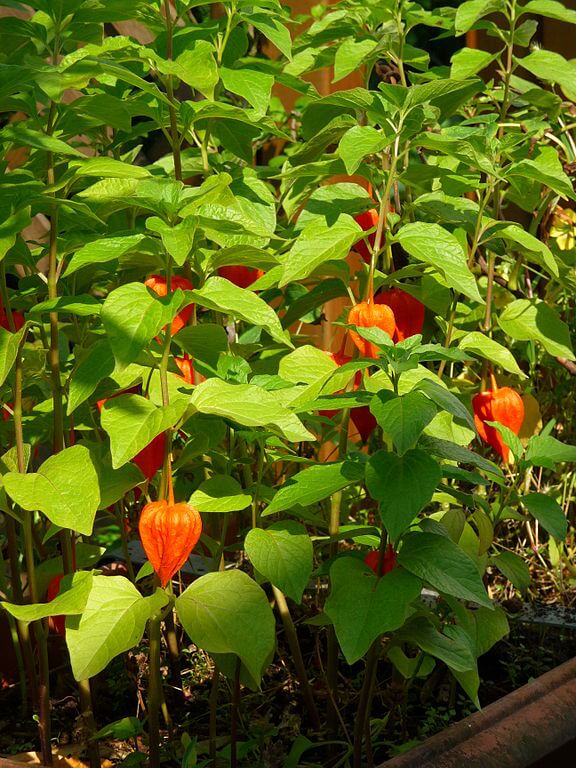

An interesting feature of the plant and its main decoration are sepals - small leaves that are located under the petals of flowers and, as they bloom, lengthen and grow together.
The box formed in this way, when ripe, often acquires bright shades, and over time dries up and becomes skeletonized.
By its appearance, the box resembles an airy chinese lantern, for which the plant got its second name.
Inside the box is a small, round, fleshy fetusresembling a miniature tomato.
In warm climates, bushes can remain evergreen, but with the onset of frost, the entire ground part dies off and new growth begins in spring from the rhizome.
Physalis vegetable varieties are capable of producing up to 2 - 3 kg. fruit from one bush.
↑ Up,
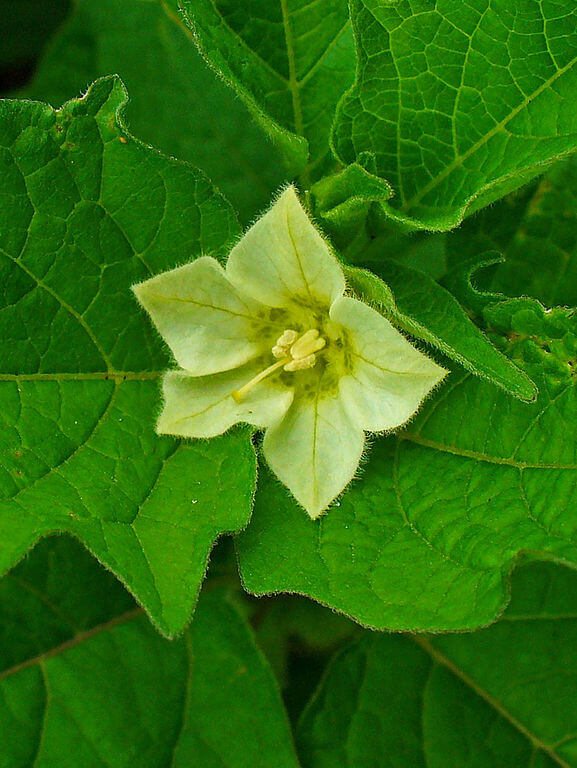

Height. In its natural habitat, it can reach 3m., but for growing in room culture, flower growers use miniature varieties up to 40 - 50 cm.
The final size of the bush will depend on the variety and the care given to it.
↑ Up,
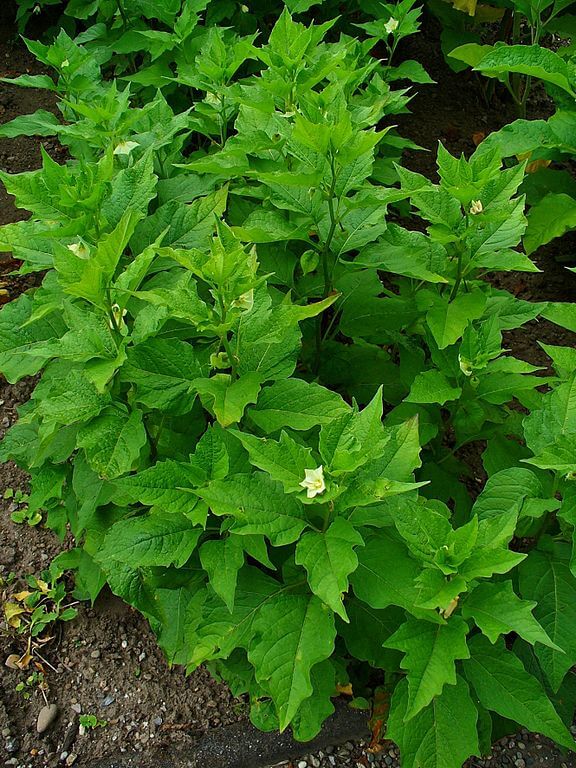

Physalis: growing, planting and care in the open field
Physalis is an incredibly beautiful flower with fiery red cups that attracts the attention of many gardeners. Recently, edible varieties have also become widespread. Well, for those who only dream of acquiring a gorgeous plant in their garden and know how to plant it outdoors, we suggest that you familiarize yourself with this article.
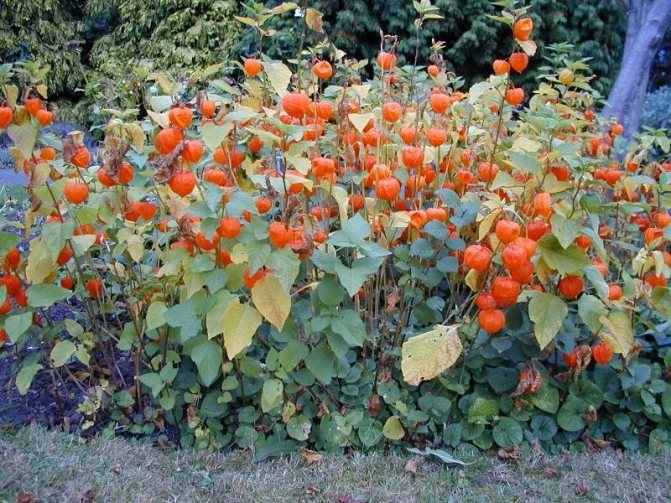

How physalis is good for health
Physalis has been known to the natives of Central and South America for more than four thousand years. They use it extensively in traditional medicine. The health benefits of berries are also scientifically proven.
Regular consumption of the fruit helps:
- Normalize the work of the cardiovascular system. Physalis is rich in potassium, magnesium and sodium. This has a positive effect on the composition of the blood. The walls of blood vessels expand, the load on the heart decreases. "Bad" cholesterol is excreted from the body. Reduces the likelihood of a heart attack, stroke, heart attack. It is also an effective prevention of atherosclerosis.
- Prevent the development of tumors, including malignant ones. The antioxidants in the pulp have anti-cancer and antibacterial properties. They prevent mutations and degeneration of healthy cells.
- Reduce the risk of developing joint diseases. Physalis is the prevention of salt deposition in the body. It is also useful in exacerbating arthritis, arthrosis, gout, and other diseases.
- Regulate blood sugar levels. Physalis fruits are very sweet, but they can be added to the diet for any type of diabetes. Due to the high content of vitamins, medications prescribed by a doctor are better absorbed.
- Improve vision. The bright yellow-orange color of the fruit indicates a high beta-carotene content. It is a source of vitamin A. Physalis also helps prevent the development of cataracts, glaucoma, stop lens clouding and macular degeneration.
- Strengthen immunity. Physalis is rich in vitamin C (more than 5 mg per 100 g). It is useful to include it in the menu for those who often suffer from colds and viral diseases, as well as when recovering in the postoperative period and in the spring, after winter beriberi. And vitamin C also stimulates metabolic processes and activates the production of collagen, which is necessary to maintain the elasticity of the skin, muscles and vascular walls. Physalis and carrot salad must have been included in the diet of victims of the Chernobyl accident - this helped to remove salts of heavy metals and decay products of radionuclides from the body.
- Strengthen your bones. Physalis is the record holder for the content of vitamin K, which is necessary for the formation of bone tissue.Its regular use is a very effective prevention of osteoporosis. It also helps prevent bone demineralization ("washing out" of calcium salts).
- Normalize the work of the digestive system. The easily digestible fiber and pectin contained in berries help the body to digest heavy foods. The risk of constipation, cramps, and bloating is noticeably reduced. All this has a beneficial effect on the state of the mucous membrane, being an effective prevention of ulcers, gastritis, and other diseases. The use of decoctions and infusions from dry fruits is especially useful.
- Slow down the aging process of the body. Antioxidant substances minimize free radical damage to the body. Physalis is also rich in copper, its presence in the diet helps to improve skin condition, get rid of fine wrinkles and age spots that appear with age.
- Accelerate the healing of wounds, ulcers, burns and so on. The iron contained in the pulp is necessary for the production of red blood cells by the body. Their high concentration in the blood means an increase in the level of hemoglobin, therefore, organs and tissues are more actively saturated with oxygen and other substances they need, and the processes of cell regeneration are accelerated. In addition to ingestion, you can apply pulp gruel to wounds. And alcohol tincture helps to get rid of scars and scars.
- Lose excess weight. Physalis is a storehouse of vitamins and minerals, while the berries are low in calories (30–35 kcal per 100 g). Fiber has a positive effect on digestion and metabolism. A decoction of dried fruits is an effective diuretic.
- Reduce the intensity of the symptoms of PMS and menopause. Unexplained mood swings, muscle cramps, migraines, attacks of unmotivated aggression and depression are associated with manganese deficiency. A decoction from the roots helps to normalize the menstrual cycle.
- Increase efficiency, reduce fatigue. Physalis is rich in B vitamins, which are necessary for the release of components from food that have a positive effect on the energy balance of the body. You can also prepare a decoction from the leaves - this is a source of flavonoids and carotenoids.
For all the undoubted health benefits of physalis, there are also contraindications. Berries are recommended to be excluded from the diet for pregnant and breastfeeding women. Do not get carried away with them with increased acidity of gastric juice. Allergic reactions are extremely rare, but allergic reactions are still possible. In the presence of any chronic diseases, it is imperative to first consult with your doctor.
All aerial parts of the plant, except for the fruit, are poisonous due to the high content of alkaloids. Therefore, when using the leaves, the dosage must be carefully observed. The "flashlight" covering the fetus is especially dangerous for health. It must be removed. Not all varieties are edible. Berries are poisonous in decorative varieties of physalis. Also, do not use those that have grown on uncultivated soils, especially calcareous ones.
Video: health benefits of physalis
Landing in open ground
Since most types of physalis tend to branch, it is recommended to plant seedlings in a checkerboard pattern at a distance of half a meter. If you have chosen a tall variety, then in the future the plant will have to be tied up, do not forget about this fact when planting. The seedling hole should be of that depth so that it is enough for up to 1 leaf.
Before planting, water is poured into the hole and the seedlings are planted directly into it so that the roots straighten naturally. After that, the hole is covered with soil and carefully compacted. Seedlings that are planted on time do not need such manipulation; after planting, they just need to be shed well.

